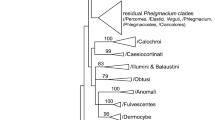Abstract
A proper phytogeographic affiliation of Antarctic lichen species has become feasible using molecular phylogeographic methods. Caloplaca citrina is a heterogeneous taxon including several species which occurs in polar regions and is common in Antarctica. Collections of C. citrina from the Antarctic were revised using morphological, anatomical and molecular characters (ITS). They were found to belong to two species: Caloplaca darbishirei (C.W. Dodge & G.E. Baker) Cretz. and C. soropelta (E.S. Hansen, Poelt & Søchting) Søchting. The molecular phylogeny showed them to be sister species, but well separated. Morphological and chemical characters, ecology and distribution of the species are discussed. C. darbishirei is the most common species in the Antarctic, and it is so far known only from Antarctica and Southern South America. C. soropelta, reported here as new to South America, is a bipolar species with all close relatives in the Southern Hemisphere; it is therefore most likely that the species colonized the Arctic from the south. C. citrina s. str. is not confirmed to occur in Antarctica. The study emphasizes the suitability of genotyping for understanding the taxonomy and phylogeography of bipolar lichens.





Similar content being viewed by others
References
Arup U (2006) A new taxonomy of the Caloplaca citrina group in the Nordic countries, except Iceland. Lichenologist 38:1–20
Castello M, Nimis PL (1995a) A critical revision of Antarctic lichens described by C. W. Dodge. Bibl Lichenol 57:71–92
Castello M, Nimis PL (1995b) The lichen vegetation of Terra Nova Bay (Victoria Land, Continental Antarctica). Bibl Lichenol 58:43–55
Dodge CW (1973) Lichen flora of the Antarctic continent and adjacent islands. Phoenix Publishing, Canaan
Dodge CW, Baker GE (1938) The second Byrd Antarctic expedition: Botany. II. Lichens and lichen parasites. Ann Mo Bot Gard 25:515–718
Ekman S (2001) Molecular phylogeny of the Bacidiaceae (Lecanorales, lichenized Ascomycota). Mycol Res 105:783–797
Fryday AM (2011) How should we deal with the Antarctic and Subantarctic taxa published by Carroll William Dodge? Opusc Philolichenum 9:89–98
Gardes M, Bruns TD (1993) ITS primers with enhanced specificity for basidiomycetes—application to the identification of mycorrhizae and rusts. Mol Ecol 2:113–118
Hansen ES, Poelt J, Søchting U (1987) Die Flechtengattung Caloplaca in Grönland. Meddr Grønland. Bioscience 25:1–52
Hertel H (1987) Progress and problems in taxonomy of Antarctic saxicolous lecideoid lichens. Bibl Lichenol 25:219–242
Hertel H (1988) Problems in monographing Antarctic crustose lichens. Polarforschung 58:65–76
Huelsenbeck JP, Ronquist F (2001) MRBAYES: Bayesian inference of phylogeny. Bioinformatics 17:754–755
Kristinsson H (1999) The 12th meeting of the Nordic Lichen Society in Eidar, Iceland 1997. Graph Scr 11:13–21
Lindblom L, Søchting U (2008) Taxonomic revision of Xanthomendoza borealis and Xanthoria mawsonii (Lecanoromycetes, Ascomycota). Lichenologist 40:399–409
Olech M (2004) Lichens of King George Island. Institute of Botany, Jagiellonian University, Kraków, Antarctica
Øvstedal DO, Lewis Smith RI (2001) Lichens of Antarctica and South Georgia: a guide to their identification and ecology. Cambridge University Press, Cambridge
Page RDM (1996) TreeView: an application to display phylogenetic trees on personal computers. Comput Appl Biosci 12:357–358
Posada D, Crandall KA (1998) Modeltest: testing the model of DNA substitution. Bioinformatics 14:817–818
Ronquist F, Huelsenbeck JP (2003) MRBAYES 3: Bayesian phylogenetic inference under mixed models. Bioinformatics 19:1572–1574
Smykla J, Krzewicka B, Wilk K, Emslie SD, Śliwa L (2011) Additions to the lichen flora of Victoria Land, Antarctica. Pol Polar Res 32:123–138
Søchting U (1992) Caloplaca soropelta (E. S. Hansen, Poelt & Søchting) Søchting comb. nov. Graph Scr 4:35–36
Søchting U (1997) Two major anthraquinone chemosyndromes in Teloschistaceae. Bibl Lichen 68:135–144
Søchting U, Olech M (1995) The lichen genus Caloplaca in polar regions. Lichenologist 27:463–471
Søchting U, Øvstedal DO, Sancho LG (2004) The lichens of Hurd Peninsula, Livingston Island, South Shetlands, Antarctica. Bibl Lichenol 88:607–658
Vondrák J, Říha P, Arup U, Søchting U (2009) The taxonomy of the Caloplaca citrina group (Teloschistaceae) in the Black Sea region; with contributions to the cryptic species concept in lichenology. Lichenologist 41:571–604
White TJ, Bruns TD, Lee SB, Taylor JW (1990) Amplification and direct sequencing of fungal ribosomal RNA genes for phylogenetics. In: Innis MA, Gelfand DH, Sninsky JJ, White TJ (eds) PCR protocols: a guide to methods and applications. Academic Press, New York, pp 315–322
Acknowledgments
Lene Christiansen performed the HPLC analyses, Lisbeth Knudsen assisted with molecular sequencing, and Bjørn Hermansen prepared the maps. Rod Seppelt, Hobart, Tasmania and Helen Peat, British Antarctic Survey, Cambridge, provided information and material from HOB and AAS, respectively. Leopoldo G. Sancho organized field work in Tierra del Fuego. Farlow Herbarium (FH) is thanked for loan of type material. The study was supported by grant 2008_01_0645 from the Carlsberg Foundation to the first author.
Author information
Authors and Affiliations
Corresponding author
Rights and permissions
About this article
Cite this article
Søchting, U., Castello, M. The polar lichens Caloplaca darbishirei and C. soropelta highlight the direction of bipolar migration. Polar Biol 35, 1143–1149 (2012). https://doi.org/10.1007/s00300-012-1161-z
Received:
Revised:
Accepted:
Published:
Issue Date:
DOI: https://doi.org/10.1007/s00300-012-1161-z




